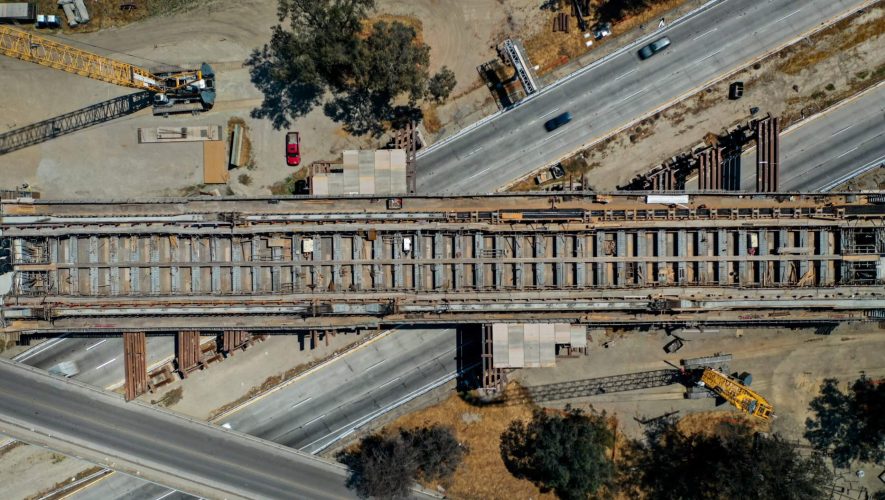High-speed rail (HSR)—intercity passenger transport with trains that reach max speeds of at least 160 mph—has captured the attention and enthusiasm of many young, sustainability-minded people. Its supporters believe that HSR, which the US currently lacks, is a climate-friendly alternative to automotive and air transportation. But they are mistaken.
Although HSR is indeed energy-efficient and carbon-clean in its operation, a comprehensive perspective that accounts for construction and maintenance costs paints a more pessimistic picture. With these caveats in mind, other forms of transportation are clearly better for shortening passenger travel times. Further, improving the US’ electrical infrastructure would deliver more substantial and immediate carbon savings.
Investment into rail infrastructure is a current topic of national discussion because the American Jobs Plan, a cornerstone of Biden’s domestic policy, is set to spend over $600 billion on transportation and infrastructure. This plan dedicates $22 billion to undefined future intercity rail opportunities via the Bipartisan Infrastructure and Build Back Better bills. The plan also dedicates $54 billion to Amtrak’s maintenance backlog, operational safety, and Northeast Corridor (NEC) railway.
The Costs of Rail Networks in the US
The National Railroad Passenger Corporation, also known as Amtrak, is a quasi-public corporation that operates intercity rail routes in the US. Private rail companies own approximately 70 percent of Amtrak’s 21,400-mile operating network, an arrangement that allows Amtrak to avoid many of the high costs associated with rail-line building. Unlike the rest of their network, Amtrak largely owns the NEC between Washington, DC and Boston. Although this corridor is the busiest passenger railroad segment in the US and currently runs at capacity, Amtrak still struggles with its funding and maintenance. Most of Biden’s proposed non-HSR spending on rail focuses on resolving the NEC’s $45.2 billion state-of-good-repair backlog and resulting delays.
HSR requires specialized and dedicated infrastructure, so Amtrak will have to build and maintain new lines to support any HSR initiatives. The Cato Institute argues that cost projections of HSR are consistently overly optimistic. HSR projects have a history of exceeding budget limits in the UK and Japan. Further, HSR infrastructure will continue to require costly maintenance even after construction. California is currently building an HSR line connecting Los Angeles and San Francisco, costing $100 million per mile. For comparison, the Interstate Highway System cost only $11 million per mile (adjusted) to build.
Cost estimates for California’s HSR project have continually increased since its inception, and its construction has been fraught with delays. California raised $9.9 billion through a bond measure in 2008 to support the project, but Governor Gavin Newsom has now requested an additional $4.2 billion to continue construction in 2022. The California High-Speed Rail Authority projects that the entire line will cost between $69 and $100 billion. Given Amtrak’s current inability to fund even the NEC corridor, these high costs bode poorly for its ability to maintain or fund any future high-cost HSR projects.
In addition to its high construction costs, the Institute of Transportation Studies (ITS) at UC Berkeley predicts that the total operating costs of the work-in-progress California line will be, at best, comparable to those of highways and much higher than those associated with air travel. The ITS finds that HSR’s only discernible operating benefits will be reduced noise, fewer accidents, and less pollution. However, even while ignoring the pollution resulting from electricity generation, the internal costs of HSR’s construction, operation, and maintenance outweigh these external benefits.
Further, HSR miles generate few positive externalities for other industries. Rail currently provides low-cost long-distance transportation for heavy freight, which HSR is unlikely to do given its higher costs and the track damage caused by heavy trains. HSR may compete with the domestic air cargo industry, though its historically poor profitability suggests lackluster returns. There thus seems to be no possible arrangement for sharing any significant portion of HSR’s infrastructure costs. Highways, however, are used for both freight and passenger transportation; investment into the highway system benefits US firms’ logistics and freight operations as well as personal travel.
Intercity Time Savings
In the aftermath of 9/11, the Transportation Security Administration (TSA) slowed air travel times by instating arduous and time-consuming airport security measures. Free from the TSA, rail is much faster to board and deboard, decreasing passengers’ total travel times.
However, some HSR proponents take this point too far, drawing questionable conclusions about the marginal time benefit of rail travel. When comparing total rail travel times with air travel times, the Seattle Transit Blog assumes that high-speed trains will travel at an average speed of 350 mph. This assumption, combined with rail terminals’s aforementioned time-savings, leads the Seattle Transit Blog to conclude that there is almost no use-case for domestic air travel in the US. However, this conclusion is overly optimistic and founded on unrealistic premises: although a test train in France did reach a record 357 mph once, modern high-speed trains regularly reach speeds of only 220 mph.
Based on existing HSR routes in Europe and Asia and recorded travel times, it is reasonable to conclude that trains servicing cities less than 310 miles away in under three hours may be able to oust air travel as the dominant intercity mode of transportation. However, regulatory investment may yield more substantial returns than infrastructure investment. Expediting airport security would improve US intercity travel times without incurring HSR’s high construction and maintenance costs. This expediting process could involve increasing TSA capacity, minimizing the amount of security theater, and expanding TSA PreCheck (or similar services).
The US High Speed Rail Association (USHSR), a non-profit organization championing HSR, claims that HSR will help eliminate congestion and traffic on highways because high-speed trains can carry a thousand passengers without delays. However, USHSR fails to specify how much car traffic intercity HSR routes can replace. Furthermore, the Brookings Institute finds that light rail investment in both Dallas and Portland failed to reduce highway congestion.
Carbon Benefit
The High Speed Rail Alliance claims that the combination of rail’s fuel efficiency with the resulting urban density around train stations will lead to less car and air travel, lowering transportation-related carbon emissions. USHSR similarly proposes that HSR is the single largest climate solution for the US’ transportation network because HSR is electrically powered and can run on clean energy.
But electrically powered does not automatically mean clean; electricity production is currently responsible for 25 percent of US carbon emissions. Because electricity is such an incredible driver of carbon dioxide production, the International Union of Railways (UIC) notes that electricity production’s decarbonization is a driving force behind European rail’s lower emissions.
On top of this, the High Speed Rail Alliance’s claims often fail to consider the carbon footprint associated with the construction of new rail networks. A 2019 UIC study on the carbon footprint of rail infrastructure finds that the new construction of railway lines only begins to reduce total carbon dioxide emissions after one to three decades, depending on ridership estimates. The more pessimistic Cato Institute uses past ridership statistics to show that trains tend to be emptier than estimates claim, with Amtrak filling an average of only 51 percent of its seats. Due to these revised estimates and regular maintenance, Cato predicts that the Los Angeles to San Francisco line will need at least seventy years, not ten to thirty, to achieve carbon neutrality. Accurate carbon cost calculations depend on accurate ridership assumptions as well as emissions information about the construction, maintenance, and use of HSR.
While HSR does boast impressive operating energy efficiency, the carbon costs of infrastructure construction and maintenance make it far less appealing than it initially seems. The confluence of assumptions about ridership and the availability of clean energy reduce the reliability of projected carbon-savings from rail. Reducing emissions from the US electrical system would more effectively and efficiently reduce total emissions.
More Promising Priorities
Taking an all-inclusive view of HSR is crucial to understanding the numerous costs and benefits associated with a US HSR network. HSR is surprisingly fast and can provide high capacity with low operating costs, yet its high infrastructure costs and frequent budget overruns outweigh its advantages. Air travel remains more time-efficient for many US trips and requires far less infrastructure. Reformulated American airport security measures can further reduce air travel times without any technological advances. Further, the carbon costs resulting from HSR’s electrical use and infrastructure negate its carbon savings. Any decrease in emissions resulting from HSR projects will only occur decades after construction, if at all, as even those distant carbon savings are dependent on high ridership and an absence of catastrophes causing infrastructure damage.
As our legislators and executives work to future-proof the American economy and invest in infrastructure, they should focus on reducing the carbon costs of electrical generation, improving the service of existing modes of passenger transportation, and investing in low-emission transportation solutions. Accurate emissions calculations must include the carbon costs resulting from the construction and maintenance of any associated infrastructure. Possible carbon-clean solutions include intracity transit, new advances in air travel, and electric vehicles.


